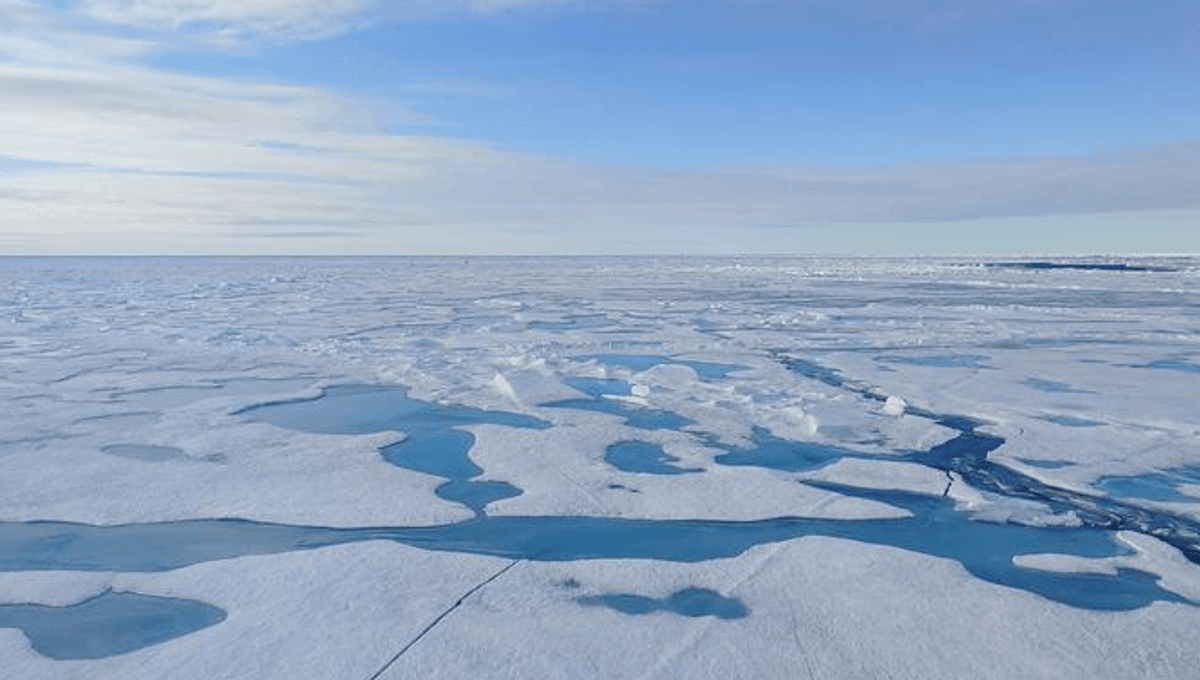
The Arctic Ocean could have a period effectively devoid of ice as soon as summer 2027, new research shows. The exact date is not a prediction; there is enough annual variation and uncertainty that the near complete absence of ice may take many years longer. One way or another, however, we are heading for summers of blue waters all the way to the poles. Shipping companies eager to finally use the North-West Passage aside, few people will like the consequences.
The extent of Arctic sea ice has been monitored by satellites since 1978, before that we have only patchy observations that tell us little of the overall state. There’s a fair bit of year-by-year noise to the data these instruments have produced, but averaged over ten years the trend is unambiguous, with summer ice falling by 12 percent per decade.
A line like that can’t go on too long until it hits zero, and the annual variation means it will reach that point occasionally well before a lack of ice becomes a permanent summer fixture. Eventually, there may come a time when not a single iceberg can be found bobbing in the waters of the northern hemisphere – but that is a long way off, as Greenland’s glaciers hurry to the sea more rapidly. Instead, polar scientists created a definition for an ice-free Arctic as when less than 1 million square kilometers (0.39 million square miles) of ice can be found within the Arctic Ocean.
Since then, considerable work has been done to work out when this might occur, including that it might have already happened without the Montreal Protocol. Most of this has involved trying to predict the first ice-free month. Updating those efforts to take account of new data, Dr Céline Heuzé of the University of Gothenburg and Dr Alexandra Jahn of the University of Colorado Boulder think it may be in the 2030s, substantially earlier than previous estimates. However, they noted that before we get to that point, there are likely to be ice-free days when ice cover dips below the million mark, before recovering somewhat within the calendar month.
“Because the first ice-free day is likely to happen earlier than the first ice-free month, we want to be prepared. It’s also important to know what events could lead to the melting of all sea ice in the Arctic Ocean,” Heuzé said in a statement.
Using 366 simulations conducted on 11 climate models, Heuzé and Jahn found we may experience ice-free days within three to six years from the most recent year with at least 3.39 million km2 (1.31 million miles2) the figure for 2023, the last year whose data could be used in the models. That prediction came from only the nine most pessimistic simulations, and would require a series of unusually, but not exceptionally, warm seasons to follow each other. These would weaken the sea ice, and slow its recovery in a cycle that would eventually lead to total disappearance in the early autumn.
Work like this takes time, and since then summer 2024 has occurred, with ice coverage ticking up slightly, so the earliest possible date is postponed to 2027. A date between 2031 and 2044 carries the highest probability.
In the absence of the underlying trend of human-induced global heating, however, back-to-back warm seasons would not be enough to make the Arctic Ocean ice-free. Periods like this have been responsible for past low ice seasons, such as in 2012, but in a hotter world, they will become more frequent and extreme until the threshold is crossed.
On the positive side, the most optimistic scenarios for global action on greenhouse gas emissions combined with some luck in seasonal variations, could see the first ice-free day pushed into the 2070s or even the 22nd century.
Initially; “The first ice-free day in the Arctic won’t change things dramatically,” Jahn said. “But it will show that we’ve fundamentally altered one of the defining characteristics of the natural environment in the Arctic Ocean, which is that it is covered by sea ice and snow year-round, through greenhouse gas emissions.” None of Heuzé and Jahn’s simulations saw the ice recover the next day. Instead, the first ice-free day was the start of an ice-free period lasting between 11 and 53 days.
That symbolic value may not have much effect, we’ve seen similar markers be largely ignored. Presumably climate change deniers will prefer to quibble about whether falling below the million square kilometers mark represents being truly “ice-free”, ignoring the fact that ice cover used to not get lower than 5.76 million km2, and 6.85 million km2 was the summer norm.
However, there are also practical consequences. For one thing, seawater absorbs sunlight, while ice reflects it. In summer, when the Sun never sets on the Arctic, the difference leads to a great deal more heat being collected, which ends up being distributed around the planet. Open ocean near the poles also leads to more erratic wind patterns and therefore extreme weather events, both hot and cold, in much more populated regions. Meanwhile, life from zooplankton to polar bears that depend on Arctic Ice may be pushed to the brink or beyond.
Ice-free Arctic summers may now be baked into our future by the gasses we have already emitted, but Jahn stresses the timing is not. “Any reductions in emissions would help preserve sea ice,” she said, delaying the reckoning even if it can’t be stopped.
The study is published in the journal Nature Communications.
Source Link: The Arctic Ocean Could Have "Ice-Free" Days This Decade